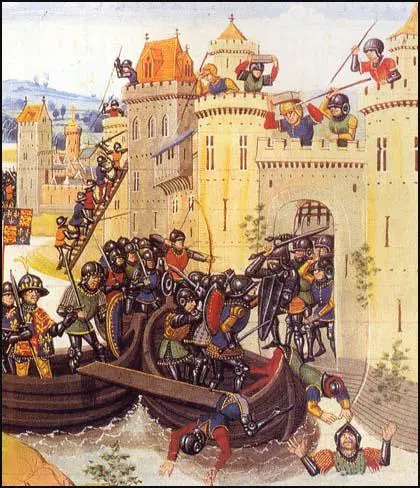Jean le Bel
(1) Jean Ie Bel was born in Liege (Belgium) in about 1290. In his youth he became a soldier. In 1327 he served in the English army in Edward Ill's campaign in Scotland. In later life he joined the Church and eventually became Canon of Saint Lambert de Liege. His book, The Chronicles of Jean le Bel, was published in about 1356.
King Philip of France had an army estimated at 20,000 men on horseback and more than a 100,000 on foot.
The King of England had no more than 4,000 horsemen, 10,000 archers and 10,000 foot-soldiers... he drew up his battalions with great care... he appointed as his commanders the Prince of Wales, the Earl of Warwick, the Earl of Stafford, the Earl of Kent and several other names I do not know... The king went among his men... begging them to be brave.
The commanders of the pikemen and the Genoese crossbowmen ordered their men forward in front of the knights so as to shoot first at the English, and they advanced close enough to loose their arrows on the enemy. But very soon the pikemen and the Genoese were routed by the English archers.
The arrows of the English were directed with such marvellous skill at the horsemen that their horses refused to advance; some leapt backwards stung to madness, some reared hideously, some turned their rear quarters towards the enemy, others merely let themselves fall to the ground, and their riders could do nothing about it. The English soldiers who were on foot advanced among them, striking them at their will.
The misfortunes of the French lasted until midnight... The King of France and his company never came close to the fighting. At the end it was necessary for the king to withdraw from where he was... Jean de Hainault... the king's bodyguard, took his bridle, and conducted him from the field...
Next morning... after the barons finished hearing mass... the king ordered Lord Reginald Cobham and the Earl of Stafford, to take a herald with a good knowledge of coats of arms... and go amongst the dead, making a list of every knight that could be recognised... They found 1,200 French knights and about 15,000 squires. Only 300 English knights were found dead.
King Edward sent his men to burn and waste the surrounding countryside... they found this easy, for there was no one to oppose them.
I have recorded the truth as exactly as I could, as I heard it from the mouth of my friend Jean de Hainault... and from ten or a dozen knights who were in the thick of the fight... and who had their horses killed under them. I have also heard similar accounts from several knights of England who were engaged on the other side.
(2) Thomas Walsingham, monk at St Albans Abbey, writing in about 1340.
1339: For five weeks the glorious King Edward III rode through the kingdom of France, and every day his army laid waste as much of the countryside as it was able. When they saw the English army approaching, the French fled in terror. All the lands of Cambrai, Tournai, the Vermandois and Loan, apart from the walled towns, churches and castles, were completely devastated.

Read The Hundred Years' War and the reports of the Battle of Crecy that were written by Jean Ie Bel and Geoffrey Ie Baker and Thomas Walsingham. Also study the pictures on these pages. Write an account on what happened at the Battle of Crecy.
